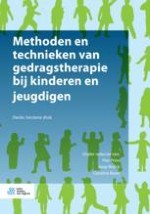Samenvatting
In dit hoofdstuk komen verschillende trends binnen de (cognitieve) gedragstherapie bij kinderen en jongeren aan de orde. Naast een uitbreiding van het type klachten waarvoor gedragstherapeutische interventies werden ontwikkeld, is er een toenemend bewustzijn van mogelijke formats waarin behandelingen het meest succesvol kunnen zijn. Hierbij wordt er steeds meer geëxperimenteerd met digitaal ondersteunde interventietechnieken, met EMDR, en met de nieuwste inzichten uit het cognitive bias modification onderzoek. Ten slotte wordt er in toenemende mate gebruikgemaakt van nieuwe therapeutische modellen. Enerzijds bouwen die modellen voort op de interventies die beschouwd worden als derde generatie gedragstherapie (bijvoorbeeld Acceptance and Commitment Therapy of Mindfulness Based Cognitive Therapy). Anderzijds bouwen ze voort op het besef dat het werken met kinderen niet mogelijk is zonder het evidence based betrekken van de context (bijvoorbeeld Attachment-Based Family Therapy of dialectische gedragstherapie).
